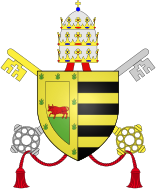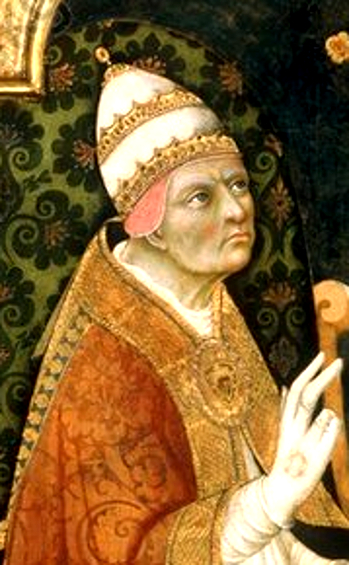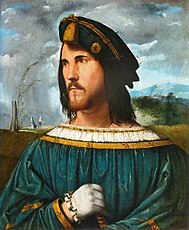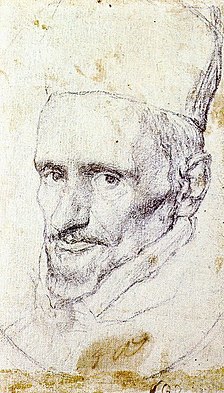User:Olokam/Workpage
| House of Borgia | |
|---|---|

|
The Borgias, also known as the Borjas, were an Italian noble family, with Spanish origins, which became prominent during the Renaissance. They were patrons of the arts and thanks to their support artists of Renaissance could spread their wings. The most brilliant personalities of this era regularly visited their court. The Borgias became prominent in ecclesiastical and political affairs in the 1400s and 1500s. Today they are remembered for their corrupt rule when one of them was Pope. They have been accused of many different crimes, generally on considerable evidence, including adultery, simony, theft, rape, bribery, incest, and murder (especially murder by arsenic poisoning[1]). Due to their search for power, they have made enemies among other powerful families, e.g. Medicis, Sforzas and Savonarolas.
History
[edit]Early History
[edit]The Borgias emerged from Valencia in Spain. Alfons de Borja, later known as Pope Callixtus III, was born in La Torreta, Canals, which was situated in the Kingdom of Valencia. He worked as a professor of law at University of Lleida and later on as a diplomat of the Kings of Aragon, before he finally became a cardinal. He was elected as Pope in 1455. At that period of time he was at an advanced age and his pontificate was expected to be rather short. Historians often state that he was incompetent and that his contempt to any luxuries or magnificence was quite famous. Pope Callixtus III made two of his nephews cardinals, when each of them was about twenty years old.
Expansion
[edit]Rodrigo
[edit]Rodrigo Borgia, one of Alfons’ nephews, was born in Xativa, also the Kingdom of Valencia. While a cardinal, he lived in an illegal relationship with Vanozza Cattanei, and they had four children: Cesare, Giovanni, Lucrezia and Gioffre. He also had other children with different women, among others Giulia Farnese. He was raised to the papal chair in 1492 and he chose the name of Alexander VI. It is said that he bought his pontificate with bribes and seventeen out of twenty-two cardinals voted for him out of greed. He was considered a good politician and diplomat, but he was also criticized for an overflow of splendor, simony (selling the church goods, offices etc.) and nepotism (favoring family members, while assigning offices). His main interests were in getting more money, seducing women and making his family as powerful as possible. He planed to establish empire with assistance of his oldest son, Giovanni, who was appointed as a commander of the papal army. Rodrigo had also honored his younger son - Cesare, eighteen years old at the time, was nominated a cardinal. Whenever Pope Alexander VI left Rome to travel, he let his daughter, Lucrezia, to be in charge of the papacy. Alexander organized alliances through the marriages of his children. At the time, Sforza family, the Milanese faction, was one of the most powerful in Europe. Alexander married Lucrezia to Giovanni Sforza and by doing so he united the Borgia and Sforza families. He also found another way of establishing his position: he married his younger son Jofre to Sancia of Aragon from Kingdom of Aragon and Naples. Rodrigo Borgia died in 1503 in Rome. The cause of death was malarial fever. His pontificate is often estimated in many extreme ways – he is often said to be the worst of all Popes. But there are also positive opinions and legends about Rodrigo, mostly strengthened by recent discoveries of different historical documents. However, the time, when Pope Alexander VI had the power in his hands is full of scandals, infringements and signs of moral offences among the highest authorities of the Latin Church.
Rodrigo’s Children
[edit]In today’s world two of Rodrigo’s children are best remembered: remorseless murderer Cesare and his heartless sister, Lucrezia.

Cesare
[edit]Cesare’s education was accurately planned by his father. Until his twelfth birthday he was educated by tutors in Rome. He studied law and the humanities at the University of Perugia, then went to the University of Pisa to study theology. As soon as he graduated from the university, his father made him a cardinal. Cesare was suspected to murder his brother, Giovanni, but there was no clear evidence that he had committed this crime. However, Giovanni’s death cleared the path for Cesare to become a layman and gain the honors his brother received from Alexander. Even though Cesare had been a cardinal, he left the holy orders to gain power and take over the position Giovanni once had – Cesare became a condottieri. He was finally married to a French princess Charlotte d’Albert. After Alexander’s death in 1503, Cesare affected the choice of a next Pope. He needed a candidate, who would not be a threat to his plans of creation his own country in Central Italy. Cesare’s candidate did become a Pope, however he also died a month after the selection. Cesare was now forced to support Giuliano della Rovere. The cardinal promised Cesare that he could keep all of his titles and honors. Despite all of his promises, Della Rovere betrayed Cesare and became his fiercest enemy. Cesare Borgia died in 1507, at the battle of Viana, while he was chasing the escaping army of Count de Lerin.[2]
Lucrezia
[edit]She was 13 years old, when her father married her to Giovanni Sforza in 1493. It was a typically political marriage. However, this relationship was annulled in 1497, when Pope Alexander VI did not need Sforzas any more and decided to get rid of the unnecessary burden, which was the presence of Giovanni Sforza. The legend says, that Lucrezia found out about her father’s plans and warned her husband. Giovanni left Rome immediately. Nevertheless this could have only been a devious act of Borgias. Alexander VI did everything in his power to cancel the marriage, and he succeeded; Lucrezia got rid of her dull husband and another profitable marriage could have been arranged. While terms of the divorce were being bargained, Lucrezia was resting in a convent. She was completely isolated from the world, and the only contact she had with the members of her family was by Perotto, a young chamberlain. Half a year later she attended a ceremony in which judges from Vatican stated that she was a virgin. The divorce could have been admitted, since as a virgin, Lucrezia could not have consumed her marriage with Giovanni. On the other hand, what these people did not know, at the time of examination Lucrezia was pregnant, carrying a baby of Perotto. The child was born in secret, and given the name of Giovanni. He was passed from one protector to another, and finally resided with Lucrezia as her half-brother. Lucrezia’s second marriage, to young and wealthy Prince of Aragon, Alfonso, allowed the Borgias to form an alliance with another powerful family. However, this relationship did not last long either. Cesare wished to strengthen his relations with France and completely break off the ones with Kingdom of Naples. As Alfonso’s father was the king of the Kingdom of Naples, young husband was in great danger. Although the first attempt of murder did not succeed, Alfonso was eventually strangled in his own quarters. The third and final husband of Lucrezia was Afonso d’Este. Even though there was an emotional connection between the couple and Lucrezia became a beloved wife, she had a few affairs at the side. Although all of them eventually ended. Lucrezia gave birth to many children, however most of them died soon after birth. When she left this world in 1519 she was buried in a tomb with her husband and one of her prematurely deceased children, Isabella Maria. Lucrezia Borgia died ten days after the death of her daughter, Isabella, due to complications during the childbirth.

Controversies
[edit]In today’s world we remember the Borgia family as ruthless murderers, people with hearts as cold as ice. Because of all the mysterious crimes surrounding them, the Borgias became exceptionally noticeable in a historical sense.
Rodrigo
[edit]There are many controversies connected with Rodrigo. He was not only accused of simony or nepotism, but also attending public orgies, along with his daughter Lucrezia. The “Ballet of the Chestnuts” (also called the “Banquet of Chestnuts”) is considered to be one of the most disputable balls of this kind. It was held on October 30, 1501. Not only Pope Alexander VI was present, but also both of his children: Lucrezia and Cesare. Rodrigo is also remembered for other crimes, many of them included torture and execution. This is how in 1498 the famous Florentine preacher Savonarola ended his life. He accused Alexander VI of corruption and called for his removal as Pope. Savonarola was tortured and then hanged and burned publically. Alexander VI is also remembered for bringing his mistresses to the papal court. One of them, Vanozza Cattanei gave him four children, and another two were born by Giulia Farnese. Giulia was taken as his mistress when she was a fifteen-year-old girl and he was over 60.

Cesare
[edit]The list of Cesare’s crimes is long and filled with cruelty. He committed more depravities than any other Borgia in human history. He was a brutal man, vicious and hot-blooded. After Cesare became a leading general of the French king Louis XII, he returned to Rome. Behind him, dragged in golden chains, was Caterina Sforza, the Lady of two of cities Cesare had conquered. She was imprisoned, held as hostage in awful conditions. And she would have died if not the French interceded for her release. Also, when Lucrezia’s second husband, Alfonso, the Duke of Bisceglie, was not important to the Borgias anymore, Cesare strangled him (or had him strangled) when he was still recovering from another attempt of assassination on his life. The first attack was also most likely to be organised by Cesare and his men. Between 1501 and 1503 Cesare hired Leonardo da Vinci as military architect and engineer, which means that da Vinci helped him conquer and then fortify fortresses. It is said that Leonardo invented war machines for Cesare and da Vinci received protection in return. Cesare allowed da Vinci to have full control over all planned and undergoing construction in his domain. Thanks to Leonardo’s merits, he received a vineyard from the family, which he later had to abandon, due to the fall of the Borgia empire. When Leonardo completed his work for Cesare, he had a tough time with finding another patron in Italy. Finally, François I of France was able to convince him to enter his service, where Leonardo would work for the final three years of his life. Some historians say that Cesare Borgia also murdered his brother Giovanni, however there is no clear evidence that he actually did. There is also the case of Perotto, Lucrezia’s lover. When Cesare found out about Lucrezia’s pregnancy, he was so furious that he had the father of the child murdered. The body of Perotto (young chamberlain, the father of the child) was fished out of Tiber. Also the body of a chambermaid was found in the river – because she gave lovers a chance to meet in secret. Both murders are believed to be commissioned by Cesare. Historian Johann Burchard, contemporary of Alexander VI, who lived in the Vatican, states about Cesare: “One day he went so far as to have the square of St Peter enclosed by a palisade, into which he ordered some prisoners - men, women and children - to be brought. He then had them bound, hand and foot, and being armed and mounted on a fiery charger, commenced a horrible attack upon them. Some he shot, and others he cut down with his sword, trampling them under his horse's feet. In less than half-an-hour, he wheeled around alone in a puddle of blood, among the dead bodies of his victims, while his Holiness and Madam Lucrezia, from a balcony, enjoyed the sight of that horrid scene.”
Lucrezia
[edit]She was rumored to be a notorious poisoner and she became famous for her skill at political intrigue. However, recently historians start to look at her in a brighter light: she is more often seen as a victim of her family’s deceptions. Many people believed that she was a criminal but the crimes of her father, Rodrigo Borgia (Pope Alexander VI), and some of her other siblings including Cesare Borgia are what gave her a bad name. [3]
Notable Members
[edit]| Name | Portrait | Description |
|---|---|---|
| Alfons de Borja |  |
Pope Callixtus III, uncle of Rodrigo Borgia. |
| Rodrigo Borgia |  |
Pope Alexander VI, father of Lucrezia, Cesare, Giovanni and Gioffre. |
| Giovanni Borgia |  |
The oldest son of Rodrigo,Giovanni was brutally murdered by an unknown perpetrator. |
| Cesare Borgia |  |
Son of Rodrigo, after Giovanni's death took over his responsibilities. |
| Lucrezia Borgia |  |
Daugther of Rodrigo. She was married three times, mostly to strengthen the position of her family. |
| Francisco Borgia |  |
Saint Francis was the great-grandson of Pope Alexander VI. |
| Innocent X |  |
Great-great-great-grandson of pope Alexander VI. |
The End
[edit]The Borgian era, or the time period when the Borgia family had its greatest influence started in the early 15th century and its glory ended approximately in 1520, about the time of the death of Lucrezia. This means that the Borgia family had influence during one of the most important periods in European history. During this period there was the age of the Renaissance, the beginning of the Age of Exploration. This was also the age of many artists, writers and rulers who have influenced our Modern age.

Even if today the Borgias are remembered for corruption, murders etc., there were of course exceptions to this. Francisco Borgia, who was the grand-grandson of Pope Alexander VI, did not follow his relatives. He had given life to a number of children and after his wife passed away, Francisco was determined to enter the Society of Jesus, recently formed by Saint Ignatius of Loyola. As a reward for his efforts, the Jesuit Francisco became canonized in 20 June 1670. Another Borgian who lived after the Borgian era was Gaspar de Borja y Velasco. As a contrast to his dead relatives, Gaspar preffered to use the Spanish spelling of Borgia, Borja. He was born at Villalpando in Spain. He was related to both Pope Callixtus III and Pope Alexander VI, and some historians do believe that Gaspar wished, just as his relatives, to become a Pope. He served as Primate of Spain, Archbishop of Seville, Archbishop and viceroy of Naples. Also, pope Innocent X was a great-great-great-grandson of Pope Alexander VI. However, he was not as cruel as his ancestors. His surname was not Borgia, so the burdens of the past did not follow him during his papacy. "Evidently, the gene pool of the Borgias was beginning to weaken"[4].
In popular culture
[edit]The Borgias were infamous in their time, and their lurid career has inspired numerous novels, plays, operas, and films. References to the Borgias in popular culture are numerous.
Novels
[edit]- The Borgias and Their Enemies by Christopher Hibbert
- Assassin's Creed: Renaissance by Oliver Bowden
- Assassin's Creed: Brotherhood by Oliver Bowden
- Prince of Foxes (1947) by Samuel Shellabarger
- The Shame of Motley by Raphael Sabatini
- The Family by Mario Puzo
- Mirror, Mirror by Gregory Maguire
- The Borgia Testament by Nigel Balchin
- The Antipope by Robert Rankin
- Borgia, the novel of a family by Klabund
- The Borgia Bride by Jeanne Kalogridis
- The Medici Seal by Theresa Breslin
- De scharlaken stad (The Scarlet City; 1952) by Hella Haasse
- Borja Papa (The Borgia Pope), by Joan Francesc Mira, is a fictional autobiography of Alexander VI.
- Summer of Night (1992) by Dan Simmons
- City of God (1979) by Cecelia Holland
- The Count of Monte Cristo by Alexandre Dumas, père
- Gone With the Wind by Margaret Mitchell
- The Book of Love by Sarah Bower
Graphic Novels
[edit]- I Borgia: La conquista del papato (Borgia 1: Blood for the Pope; 2004) by Alejandro Jodorowsky and Milo Manara
- I Borgia: Il potere e l'incesto (Borgia 2: Power and Incest; 2006) by Alejandro Jodorowsky and Milo Manara
- I Borgia: III Le fiamme del rogo (Borgia 3: The Flames of the Pyre; 2008) by Alejandro Jodorowsky and Milo Manara
- Cantarella by You Higuri (manga)
- Cesare by Souryo Fuyumi (manga)
Plays
[edit]- Lucrezia Borgia, by Victor Hugo
- The Tyrant: An Episode in the Career of Cesare Borgia, a Play in Four Acts (1925), by Raphael Sabatini
- The Memory of Water, by Shelagh Stephenson
- Valentino: a play in verse, by David Wisehart
Music
[edit]- Dinastia Borgia Eglise et Pouvoir à la Renaissance: Compilation of music associated with the Borgias. Hespèrion XXI, Jordi Savall
Operas
[edit]- Lucrezia Borgia (1833), by Gaetano Donizetti
Films
[edit]- Prince of Foxes (1949), starring Orson Welles
- [Los Borgia] Error: {{Lang}}: text has italic markup (help) (2006)
- The Borgias (1981), BBC miniseries
- Contes immoraux, a film by Walerian Borowczyk.
- The Conclave, (2006), a film by Paul Donovan.
- Assassin's Creed: Lineage (2009)
- The Borgias (2011), Showtime miniseries
- Borgata (2013), Wynn casino extension
- The Godfather: Part III (1990), Michael Corleone exclaims " The Borgias!" in reference to the corrupt Clergy
Businesses
[edit]Video Games
[edit]- Assassin's Creed II (2009), Ubisoft
- Assassin's Creed II: Discovery (2009), Ubisoft
- Assassin's Creed: Brotherhood (2010), Ubisoft
Television
[edit]- History Bites episode "The Osborgias" (depicts the family in the style of The Osbournes)
- Frasier episode "Dark Victory," from the second season.
- French premium-pay TV Canal Plus, Lagardère Entertainment, and EOS Entertainment are working on the production of a historical drama series about the rise of the Borgia dynasty since early 2009. Written by Tom Fontana (Oz, Homicide), Borgia will follow the famous crime family through its reign of terror at the Vatican at the turn of the 16th century when Rodrigo Borgia was pope. The series will be shot in English from May to December 2010 in the Czech Republic. The 12-episode, 52-minute series will be made on a budget of €30 million ($44 million).
- The Walt Disney movies The Shaggy Dog and its sequel The Shaggy D.A. have a ring once owned by Lucretia Borgia playing a significant role in their storylines.
- In January 2010, American premium pay TV Showtime has announced the order of ten episodes of a historical drama based on the Borgia family called The Borgias. Oscar winner Jeremy Irons will play Rodrigo Borgia, and Neil Jordan (The Crying Game, The Tudors) will direct. The network plans a spring 2011 premiere.
- Alexandra Borgia, a character from Law & Order.
Notes
[edit]- ^ Arsenic: A Murderous History. Dartmouth Toxic Metals Research Program, 2009
- ^ M. Bellonci, Lukrecja Borgia, Warszawa 1988, p. 555-556
- ^ Lucrezia Borgia: A Biography. Rachel Erlanger, 1978
- ^ http://www.trutv.com/library/crime/serial_killers/history/borgias/5.html
Category:Families of post-ancient Rome Category:Papal families Category:Roman Catholic families
References
[edit]- Fusero, Clemete. The Borgias. New York, Praeger Publishers, 1966.
- Grun, Bernard. The Timetables of History. New York, Simon and Schusters, 1946, pp. 218, 220, 222.
- Hale, John R. Renaissance. New York, Time-Life Books, 1965, p. 85.
- [1]. "Mad Dogs and Spaniards: An Interview with Cesare Borgia." World and Image, 1996.
- Rath, John R. "Borgia." World Book Encyclopedia. 1994 edition. World Book Inc., 1917, pp. 499-500.
- Catholic Encyclopedia, Volume 1. (Old Catholic Encyclopedia) New York, Robert Appleton Company (a.k.a. The Encyclopedia Press), 1907.

